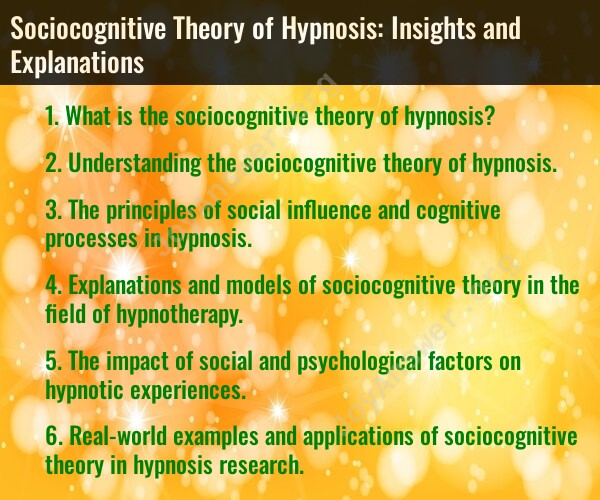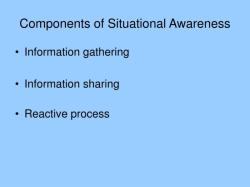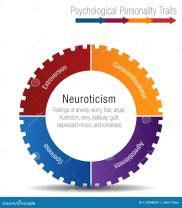What is the sociocognitive theory of hypnosis?
The sociocognitive theory of hypnosis is a perspective that explains hypnosis as a result of social and cognitive factors rather than a distinct altered state of consciousness. This theory challenges the traditional view of hypnosis as a unique and mysterious trance-like state and suggests that hypnotic phenomena can be understood by considering the interaction between the hypnotist, the hypnotized person, and their beliefs and expectations. Here are the key insights and explanations of the sociocognitive theory of hypnosis:
Social Role and Expectations: In the sociocognitive theory, hypnosis is seen as a social role. The hypnotist plays the role of an authoritative figure, and the hypnotized person assumes the role of a compliant and suggestible participant. Both parties are aware of these roles, and they work together to create the hypnotic experience.
Expectations and Beliefs: The theory emphasizes the importance of the hypnotized person's expectations and beliefs. When people enter a hypnotic situation with the expectation that they will experience altered perceptions or behaviors, they are more likely to do so. These expectations can lead to suggestibility and a willingness to comply with the hypnotist's suggestions.
Suggestion and Compliance: Hypnotic suggestions are not commands that override an individual's will. Instead, they are proposals that the person may choose to follow. Compliance with suggestions is based on the person's willingness to cooperate and their belief that the suggestions will lead to the desired experience.
Role of Imagination: Imagination plays a crucial role in hypnosis. Hypnotized individuals may use their imagination to create vivid mental images or scenarios in response to suggestions. This is not necessarily indicative of a separate altered state of consciousness but rather the power of suggestion combined with a person's imaginative abilities.
No Altered State of Consciousness: According to the sociocognitive theory, there is no unique or altered state of consciousness associated with hypnosis. Instead, hypnotic experiences can be explained by social influence, cognitive processes, and role-playing.
Variability of Hypnotic Responsiveness: This theory acknowledges that people vary in their responsiveness to hypnosis. Some individuals may be more suggestible and prone to engage in the role-playing aspect of hypnosis, while others may be less responsive.
Application of Hypnosis: The sociocognitive theory has implications for the use of hypnosis in therapeutic settings. It suggests that the effectiveness of hypnotherapy may be due to the power of suggestion and the person's belief in the process rather than an altered state of consciousness.
Overall, the sociocognitive theory of hypnosis offers a perspective that demystifies hypnosis and views it as a socially and cognitively influenced phenomenon. It emphasizes the importance of the interpersonal relationship between the hypnotist and the participant, the role of expectations and beliefs, and the power of suggestion in shaping hypnotic experiences. This theory has led to a more pragmatic and practical approach to understanding and using hypnosis for therapeutic and research purposes.
Understanding the sociocognitive theory of hypnosis
The sociocognitive theory of hypnosis is a theoretical framework that explains hypnosis as a social interaction between the hypnotist and the participant. The theory posits that participants in hypnosis enact the role of a hypnotized person, as they understand it, in order to meet the expectations of the hypnotist and the social situation.
The principles of social influence and cognitive processes in hypnosis
The sociocognitive theory of hypnosis incorporates a number of principles from social psychology and cognitive psychology, including:
- Social influence: The theory posits that participants in hypnosis are influenced by the hypnotist's suggestions and expectations. For example, if a hypnotist suggests that a participant is feeling sleepy, the participant is more likely to feel sleepy.
- Cognitive processes: The theory also posits that participants in hypnosis use a variety of cognitive processes, such as imagination, attention, and memory, to create and maintain the hypnotic experience. For example, a participant may imagine themselves being in a different place or time, or they may focus on the hypnotist's voice and suggestions.
Explanations and models of sociocognitive theory in the field of hypnotherapy
There are a number of different explanations and models of the sociocognitive theory of hypnosis in the field of hypnotherapy. One popular model is the "hypnotic role enactment" model, which posits that participants in hypnosis enact the role of a hypnotized person, as they understand it, in order to meet the expectations of the hypnotist and the social situation.
Another popular model is the "source monitoring" model, which posits that participants in hypnosis have difficulty distinguishing between their own thoughts and feelings and the suggestions of the hypnotist. This can lead to participants experiencing the hypnotist's suggestions as their own thoughts and feelings, which can lead to a variety of hypnotic phenomena, such as hallucinations and age regression.
The impact of social and psychological factors on hypnotic experiences
A number of social and psychological factors can influence hypnotic experiences. For example, the relationship between the hypnotist and the participant, the participant's expectations about hypnosis, and the participant's level of motivation to be hypnotized can all play a role.
Research has shown that participants who have a positive relationship with the hypnotist and who are highly motivated to be hypnotized are more likely to experience hypnosis. Additionally, participants who have positive expectations about hypnosis are also more likely to experience hypnosis.
Real-world examples and applications of sociocognitive theory in hypnosis research
The sociocognitive theory of hypnosis has been used to explain a variety of hypnotic phenomena, including:
- Hypnotic amnesia: Participants in hypnosis can be instructed to forget certain information or events. This can be explained by the sociocognitive theory of hypnosis by positing that participants are motivated to please the hypnotist and to meet the expectations of the hypnotic situation.
- Hypnotic analgesia: Participants in hypnosis can be made insensitive to pain. This can be explained by the sociocognitive theory of hypnosis by positing that participants are using their cognitive abilities to focus on the hypnotist's suggestions and to dissociate themselves from the painful experience.
- Hypnotic hallucinations: Participants in hypnosis can be made to see, hear, smell, taste, or feel things that are not actually there. This can be explained by the sociocognitive theory of hypnosis by positing that participants are using their imagination to create these experiences.
The sociocognitive theory of hypnosis is a valuable tool for understanding the hypnotic experience. It has been used to develop new and effective hypnotherapy techniques, and it continues to be an area of active research.












